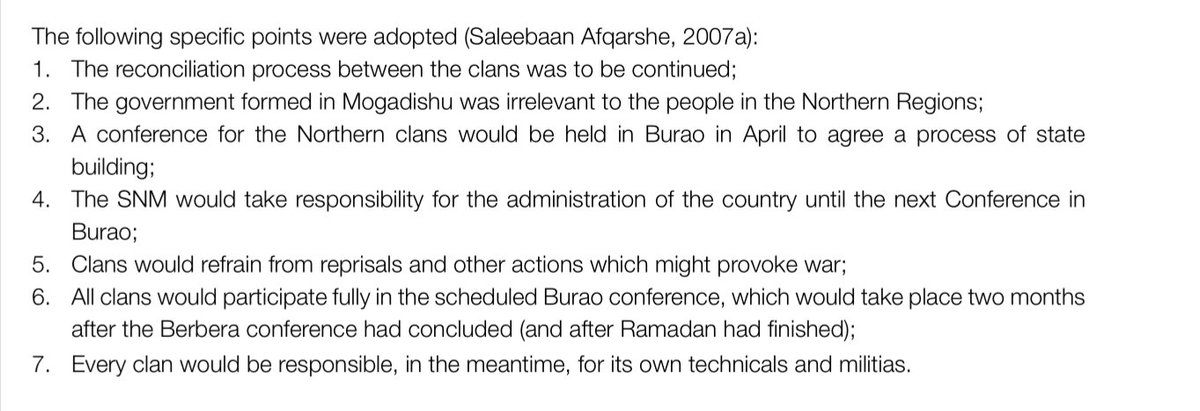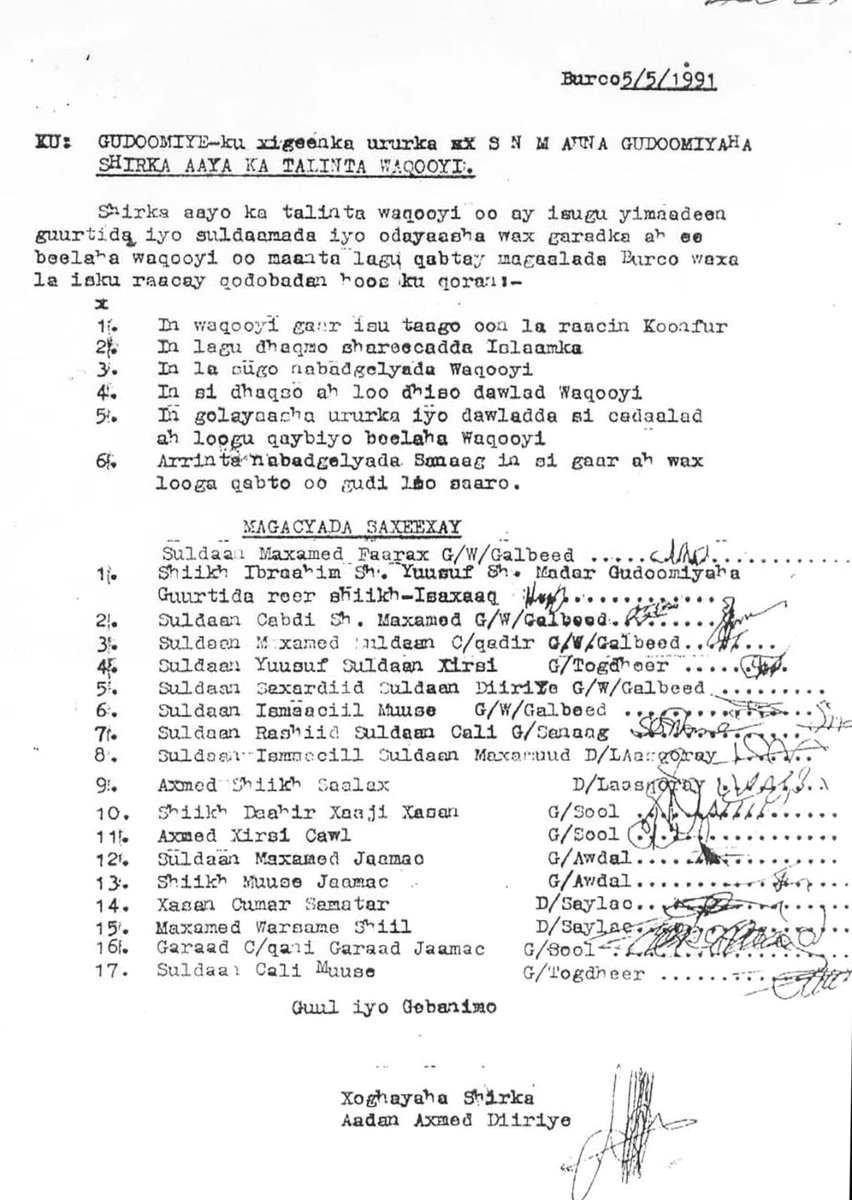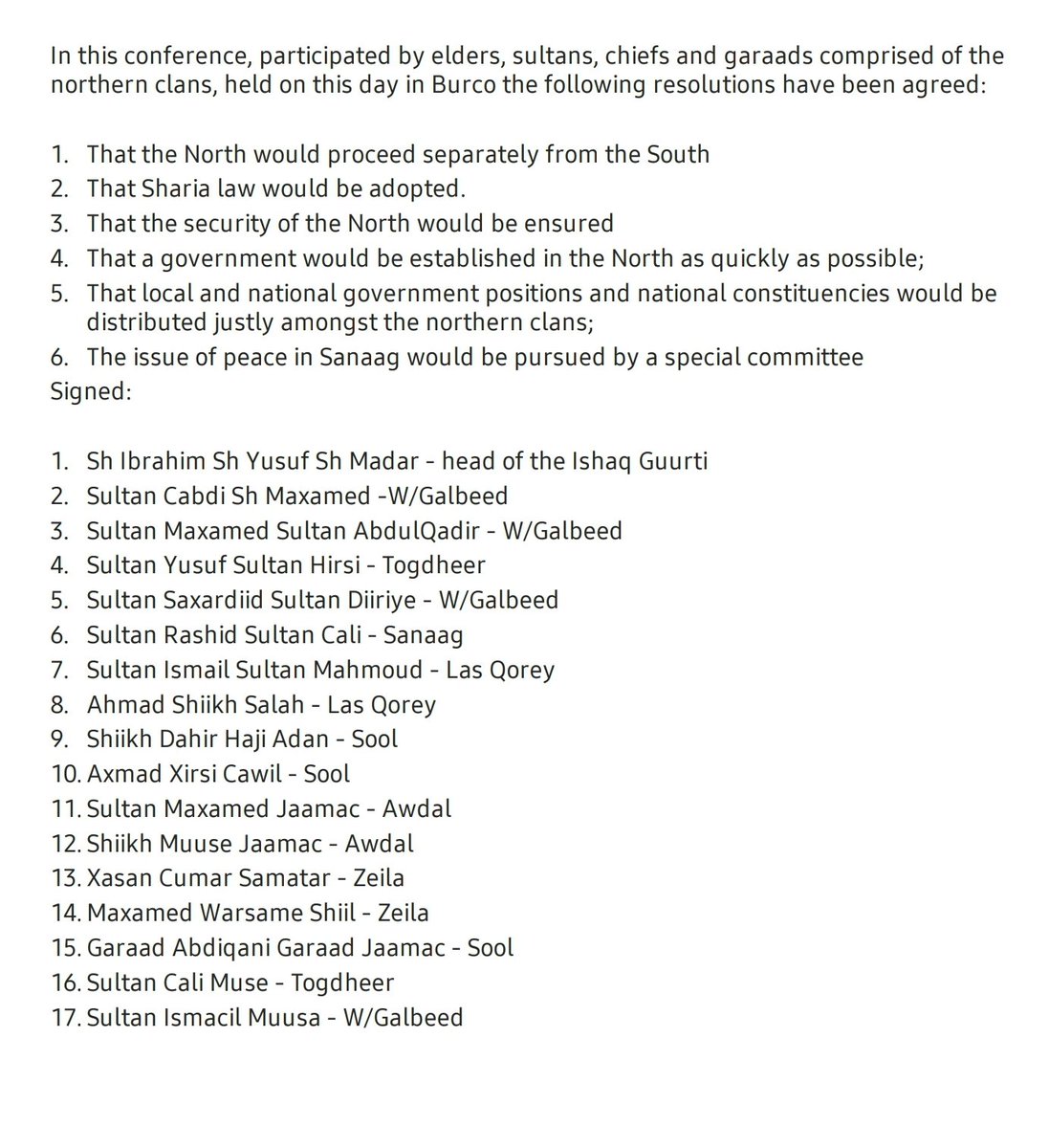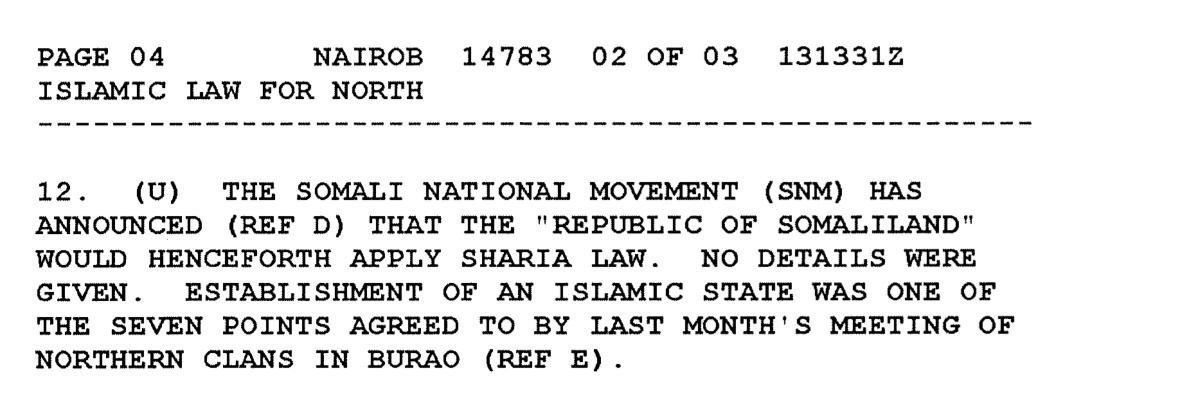[Series]
SL& #39;s indigenous method of state building.
Somaliland was created in order to be structured around traditional Somali values and law systems, meshed with the structure of a constitutional democracy.
Part One: The peace building process: peace between clans
/1
SL& #39;s indigenous method of state building.
Somaliland was created in order to be structured around traditional Somali values and law systems, meshed with the structure of a constitutional democracy.
Part One: The peace building process: peace between clans
/1
The steps to create some sort of multi-tribal state began with a series of conferences between the years 1990-1993 across the north. The first of these was the Oog conference in 1991, held after the Calan Cas (Red Banner) units of the SNM successfully liberated Burco /2
During the civil war the only non-Isaaq tribe that had allied itself with the SNM had been the Issa, therefore the other neighbouring clans expressed concerns about possible rogue reprisals, this led to delegations being formed by elders- /3
Most of the following information comes from the interviews by the late Garaad Saleeban Afqarshe, he recounts the first peace missions being formed in 1990 particularly amongst the Hawd clans where watering holes are shared. The war was raging still, in 1990 /4
These meetings that happened under the guidelines of tradition resulted in peace between the Dhulbahante and the Habr Yonis and the Habr Jeclo, this peace was of mutual interest as all three clans share grazing lands in the hawd. Attached is the list of meetings during wartime /4
With the disagreements with regards to the exact dates of these tribal meetings, what isn& #39;t denied is them taking place. The peace process actually happened in the east first before the West, where the large SNA military base remained manned and fortified at Dilla, Awdal /5
The delegations led by Garaad Abdiqani led to an invitation by the SNM political leaders at their HQ Baligubadle. The Garaad and his delegation stayed for 10 days, culminating with a meeting with the SNM executive committee on the 25th-26th of September 1990 /6
During this meeting both sides expressed their commitment to peace building, the Garaad expressed his condemnation of the acts of the regime. The SNM leaders also expressed that the crimes of the regime were not to be blamed on a clan, although individuals would be accountable /7
Once the meeting was over, the Garaad set out for Las Anod to continue his peace building efforts in Sool, leaving some members of his delegation at Baligubadle, a gesture of goodwill between brotherly tribes. /8
Once the regime was defeated, the Garaad aswell as military officers from the dhulbahante communicated to the SNM via radio in Las Anod, fixing a date, time and place for the first peace conference, Oog was chosen as the venue, traditionally a border town between the tribes. /9
Garaad S. Afqarshe mentioned how nerves were raised as to the possibility of the SNM committing a treacherous attack, but the SNM left their weapons outside the town. Many of the SNM commanders & the military officers of the Dhulbahante present had been colleagues in the SNA /10
The meeting was successful and 10 years of hostilities between the neighbouring tribes ended with both sides agreeing to create environments of non violence in their regions, a second conference at Berbera was scheduled which sought to invite all northern tribes /11
The Berbera conference, called & #39;Shirka Walaalaynta Beelaha Waaqooyiga"(Brotherhood Conference of Northern Clans) was the first of its kind, 30 SNM members, Ciise, Warsangeli, Dhulbahante, Gadabursi elders all attended. A major issue was that of possible reprisals by the SNM /12
The elders had expressed their concerns of the possibility of uncontrollable units of the SNM carrying out reprisals against tribes simply because of their battle with the regime, many officers of the regime were captured in Berbera, and their treatment was an example /13
A commander of the Calan Cas (GX units), Sumunni had the Isaaq officers of the regime executed, and had the majority of the remaining officers released and given safe passage. This was sufficient enough for the elders to agree on ceasefire. Several points were adopted: /14
The following attachment describes the points that were adopted, Garaad Afqarshe, a participant in the conference is cited as a reference. The of "Shirka Walaalaynta Beelaha Waaqooyiga" in Berbera had led to the pronouncement of a conference in Burco 24/4-4/6 1991 /15
The purpose of the conference was to establish governance across the northern regions, it was called "Shirweynaha Walaalaynta Beelaha Waaqooyiga/ Grand Brotherhood Conference of Northern Clans"
Two meetings had been scheduled
- Northern Clan Elders
- SNM Exec. Committee
/16
Two meetings had been scheduled
- Northern Clan Elders
- SNM Exec. Committee
/16
The SNM committee had convened a meeting in a bullet ruined hall in Burco& #39;s shacab neighborhood, the elders like their ancestors sat under a large tree. The tribes had ten representatives each, with the Isaaq having a slight majority due to Cissa being represented among them /17
The following resolutions were agreed amongst the elders, a sub committee of 17 of the 79 present signed the resolutions on the 5th of May. They are attached and translated.
It& #39;s worth mentioning that the second resolution regarding Shariica attracted the US& #39;s attention. /18
It& #39;s worth mentioning that the second resolution regarding Shariica attracted the US& #39;s attention. /18
During a review of the resolutions the SNM committee added a seventh resolution (hence the US cable), mentioning the prioritization of SNM fighters holding positions in the upcoming police and security sector, this decision by the SNM leaders was to speed up demobilisation /19
As I end this first part of this three part series, I& #39;d like to remind the reader that no such example of nation building in the horn exists. Regardless of how SL turned out 2010 onwards, none can deny the genuine effort made between the tribes once regime forces were purged /20
Correction: Mujahid Sumuni wasn& #39;t a commander of the Red Banner units (whi were HA)

 Read on Twitter
Read on Twitter






